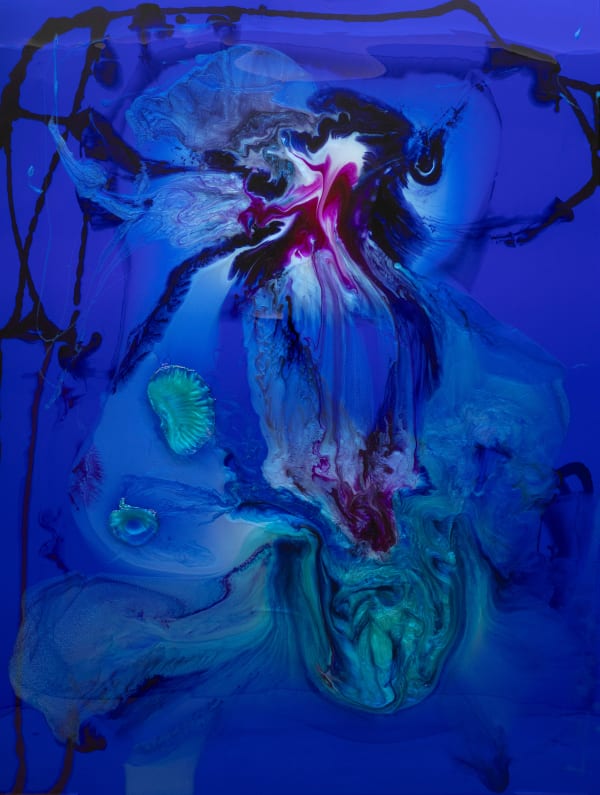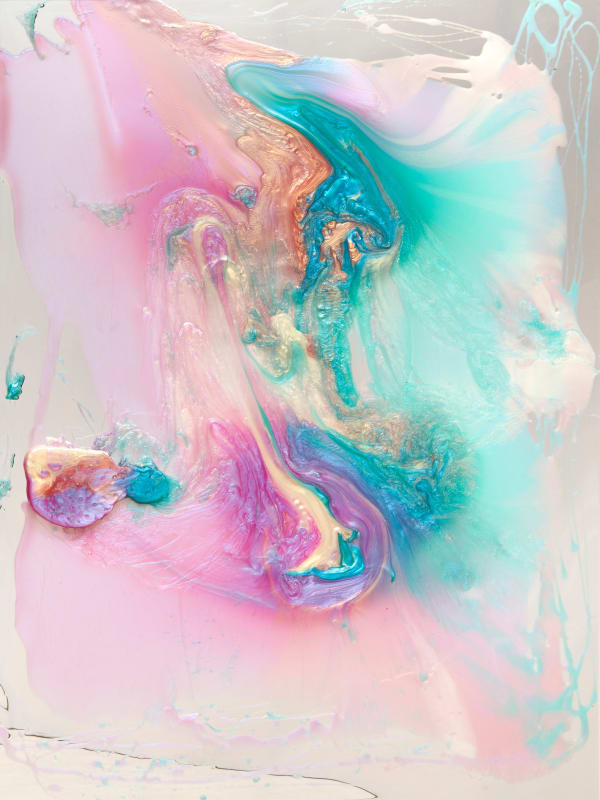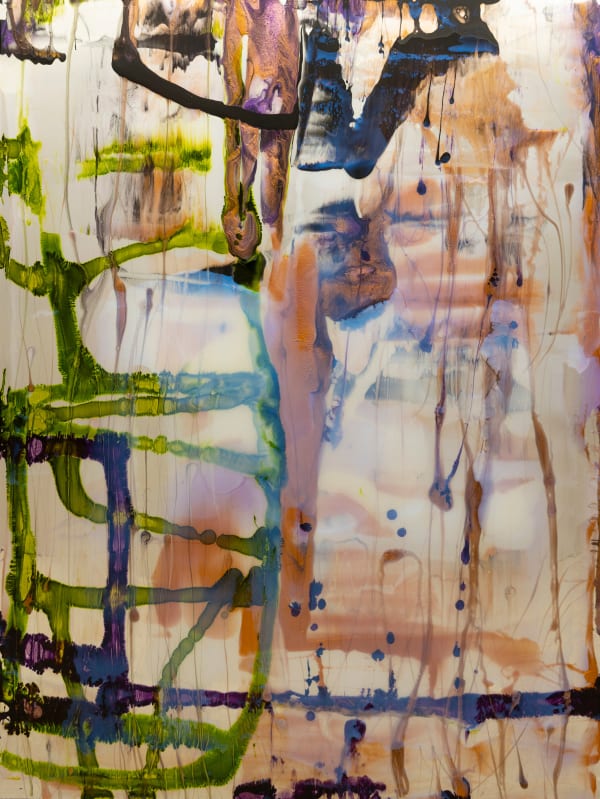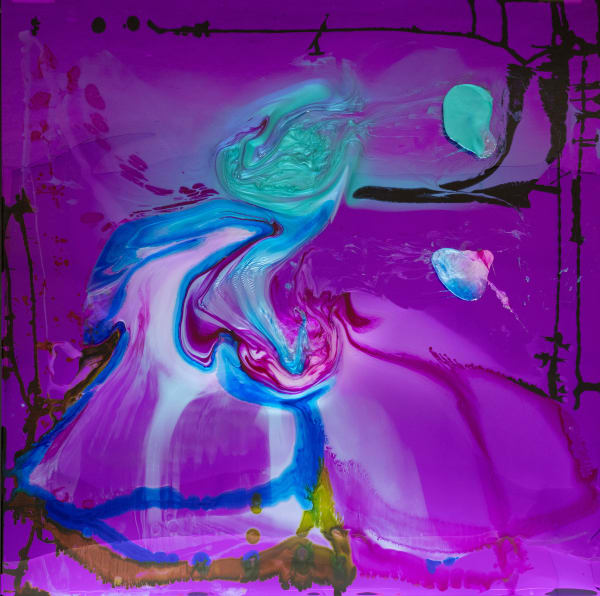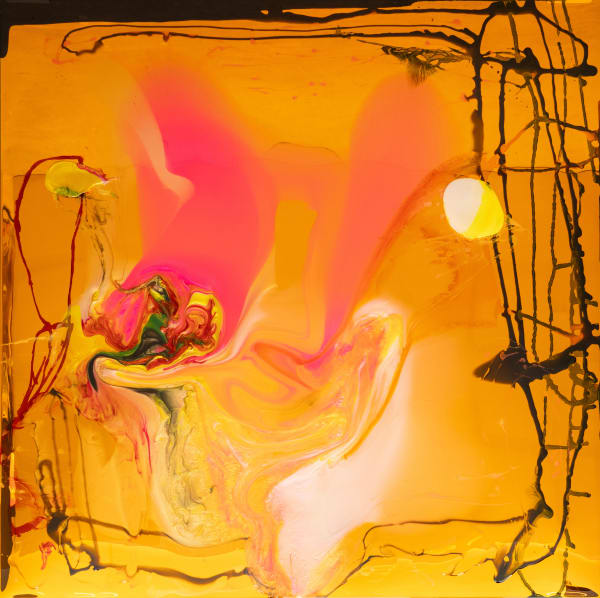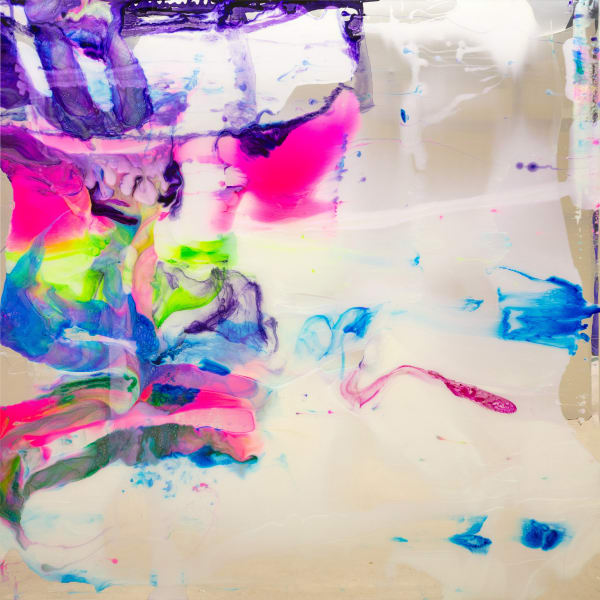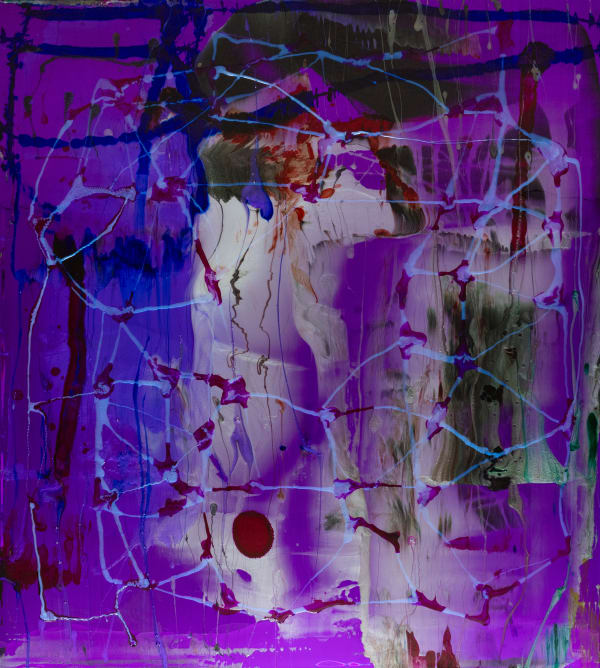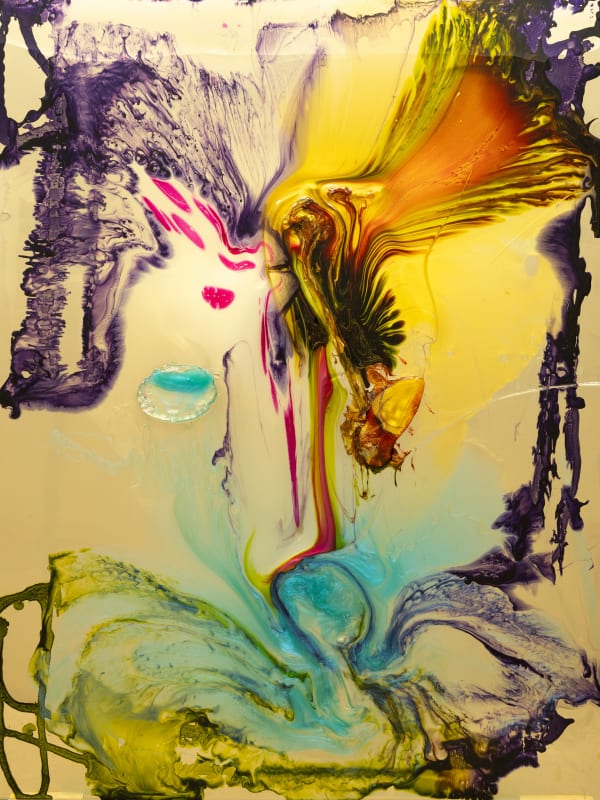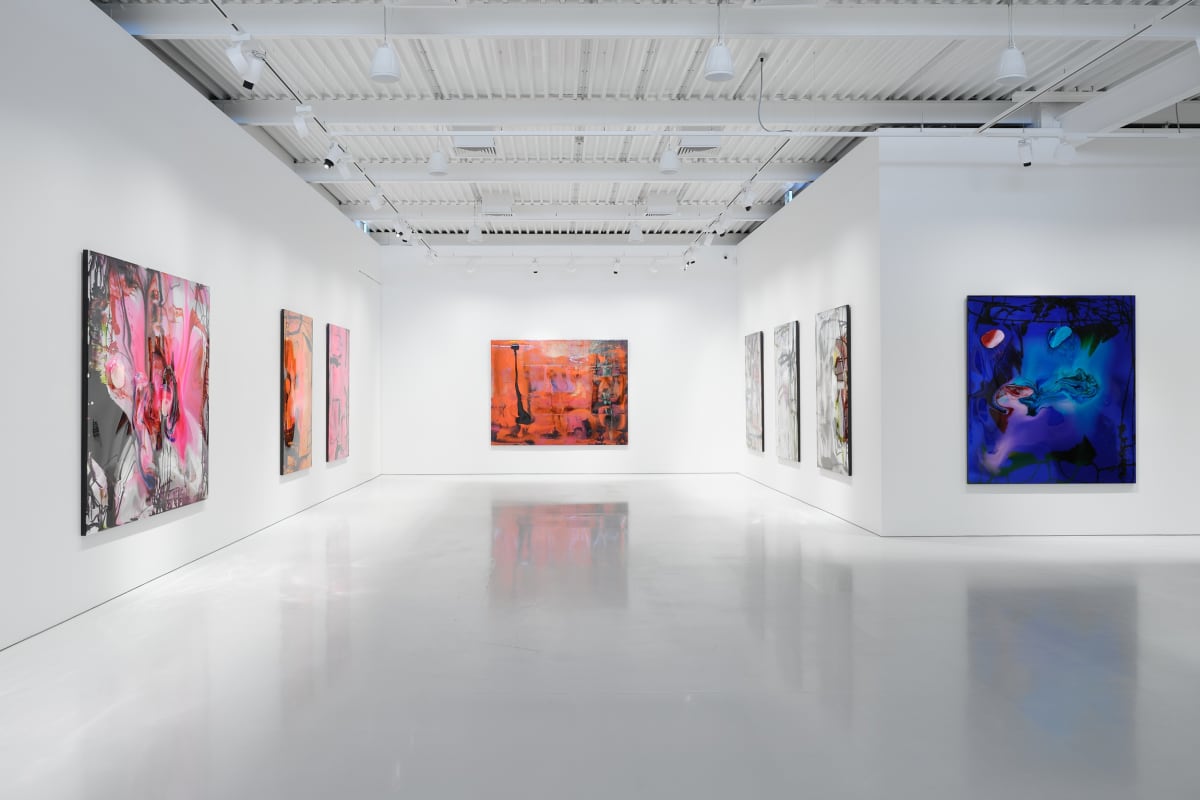Dale Frank
While links to medium-specific history hold, in some ways Frank’s work has no real precedents. He has crafted an entire artistic oeuvre from acrylic resin, a material that did not exist for most of the history of painting. This necessarily situates his work in a post-industrialist discourse of the ‘expanded field’ of painting. It is this confluence of associations and critical engagements that bring a depth of complexity to Frank’s paintings.
Dale Frank’s latest exhibition at Gow Langsford Onehunga continues his bold exploration of painting’s material and conceptual boundaries. Renowned for his distinctive resin works—luminous, fluid, and technically complex—Frank’s practice engages with the historical lineage of painting while simultaneously pushing it into new terrain. His vivid compositions, layered with rich colour and unpredictable movement, reflect a career spanning five decades of artistic innovation. Characterised by evocative and often enigmatic titles, Frank’s works exist in a space between abstraction, material experimentation, and contemporary culture. This exhibition presents a compelling selection of new paintings that highlight his ever-evolving approach to the medium.
Read the essay Dale Frank - Sheen and Substance by Julian McKinnon below.
Gow Langsford Onehunga
4 Princes Street, Onehunga, Auckland
Open Thursday-Friday 10-5pm, Saturday* 10-4pm; otherwise by appointment only.
*Please note the gallery will be closed to the public on Saturday 5th April for a private event.
-
 Dale Frank, In the silence, in the night, far from people, alone he was most at home..., 2024
Dale Frank, In the silence, in the night, far from people, alone he was most at home..., 2024 -
 Dale Frank, The illusion of creepy people or homeless people, 2022
Dale Frank, The illusion of creepy people or homeless people, 2022 -
 Dale Frank, Timothee Chalamet and the peach, 2024
Dale Frank, Timothee Chalamet and the peach, 2024 -
 Dale Frank, She would always send him texts, saying what about next week, 2024
Dale Frank, She would always send him texts, saying what about next week, 2024 -
 Dale Frank, He chain smoked Long Beach Red..., 2024
Dale Frank, He chain smoked Long Beach Red..., 2024 -
 Dale Frank, She said she was lonely, she said she was empty, 2024
Dale Frank, She said she was lonely, she said she was empty, 2024 -
 Dale Frank, She really felt she deserved luxury, the best, the most expensive designer handbags..., 2024
Dale Frank, She really felt she deserved luxury, the best, the most expensive designer handbags..., 2024 -
 Dale Frank, He would often sit on his usual park bench, lingering longer after lunch to avoid people..., 2024
Dale Frank, He would often sit on his usual park bench, lingering longer after lunch to avoid people..., 2024 -
 Dale Frank, There, their love making was extremely messy..., 2024
Dale Frank, There, their love making was extremely messy..., 2024 -
 Dale Frank, Nick was a hit in the slums of Mumbai..., 2023
Dale Frank, Nick was a hit in the slums of Mumbai..., 2023 -
 Dale Frank, The tenuous flexing orientalist nature of their relationship only became apparent when he wanted to bbq on their balcony, not for obvious reasons, 2024
Dale Frank, The tenuous flexing orientalist nature of their relationship only became apparent when he wanted to bbq on their balcony, not for obvious reasons, 2024 -
 Dale Frank, She often lost all sense of time, dinner, work..., 2023
Dale Frank, She often lost all sense of time, dinner, work..., 2023 -
 Dale Frank, He did not realise rock bottom had a basement until he started dating Cassandra, 2024
Dale Frank, He did not realise rock bottom had a basement until he started dating Cassandra, 2024 -
 Dale Frank, He would wander at night for hours on end around his claustrophobic, cramped crawling 9th floor apartment..., 2024
Dale Frank, He would wander at night for hours on end around his claustrophobic, cramped crawling 9th floor apartment..., 2024 -
 Dale Frank, He opened a go fund me page ?, 2024
Dale Frank, He opened a go fund me page ?, 2024 -
 Dale Frank, She suffered from Heteropaternal Superfecundation three times in her marriage, 2024
Dale Frank, She suffered from Heteropaternal Superfecundation three times in her marriage, 2024 -
 Dale Frank, He changed his address three times in two years just so he could feel closer, and catch a glimpse of her, 2024
Dale Frank, He changed his address three times in two years just so he could feel closer, and catch a glimpse of her, 2024 -
 Dale Frank, Sleeping in a men's Hostel..., 2024
Dale Frank, Sleeping in a men's Hostel..., 2024 -
 Dale Frank, She said her neighbourhood was filled with villains and creeps and she could not tell who was straight, 2024
Dale Frank, She said her neighbourhood was filled with villains and creeps and she could not tell who was straight, 2024 -
 Dale Frank, What he knew at 16, what he knew at 36, what he knew at 56, 2024
Dale Frank, What he knew at 16, what he knew at 36, what he knew at 56, 2024 -
 Dale Frank, The more he believed in his attraction, the more he thought he was sexually attractive..., 2024
Dale Frank, The more he believed in his attraction, the more he thought he was sexually attractive..., 2024 -
 Dale Frank, The barnacles of the huge dark whale pierced, cerated, sliced open his flesh, 2024
Dale Frank, The barnacles of the huge dark whale pierced, cerated, sliced open his flesh, 2024 -
 Dale Frank, He said it was empty, he said he was lonely, 2024
Dale Frank, He said it was empty, he said he was lonely, 2024
Dale Frank – Sheen and Substance
Essay by Julian McKinnon
Contemporary art occupies a nexus of historic tradition, ideological aspiration, and raw commerce. To some, it is a continuation of human visual communication and meaning-making that stretches back to the palaeolithic cave drawings of Lascaux and even more ancient sites. Some see it as a rich form of expression created by special divinators – artists – who are bestowed with elusive gifts or talents. For others, art sits in a special category of financial assets. Dale Frank’s artistic output seems to perfectly exemplify this entangled set of conditions.
Frank’s practice is engaged with painting as a historic medium. One could read it in the lineage of American Abstract-Expressionism, with parallels to artists such as Jackson Pollock, Helen Frankenthaler, and even Paul Thek, or the abstract works of the influential German post-war painter Gerhard Richter. Frank has confessed that whilst based in Europe as a young artist, his weekends outside his studio were immersed with hours at the Van Gogh in Amsterdam, attending Late Punk concerts and exhibitions, and days spent at the Futurist Museum and private Arte Povera Collections in Milan. Frank was intimately involved with contemporary European artists in the 1980s and 1990s; Jiri George Dokoupil, Sigmar Polke, Albert Oehlan, in friendships, discussions, and occasionally joint exhibitions. This created the foundation and the education for Frank’s working studio processes. Yet, now Frank’s medium is not comprised of paint in a traditional sense, using polymer materials instead; Easycast resins, transparent dyes and ink, traditional 19th century powder pigments mixed with resin, Epoxy glass. Some might argue that puts it into a different category of artmaking altogether. What links Frank’s work to painting as a historic medium is what German theorist Isabelle Graw refers to as the ‘specific indexicality’ of painting. [1] This is a semiotic framework or set of visual cues that reference painting and expand upon its traditional constraints. In Frank’s colourful yet intentional, always deliberate marks, one can detect the gestural and technical efforts that have brought the work into being – the ‘indexical trace’ of the artist as Graw would put it.
While links to medium-specific history hold, in some ways Frank’s work has no real precedents. He has crafted an entire artistic oeuvre from acrylic resin, a material that did not exist for most of the history of painting. This necessarily situates his work in a post-industrialist discourse of the ‘expanded field’ of painting. It is this confluence of associations and critical engagements that bring a depth of complexity to Frank’s paintings. In a similar vein, Australian writer and curator Amelia Winata has stated, “To be sure, perhaps the most critical aspect of Frank's paintings is that they constantly operate in a process of back and forth that circumvents the idea of start and end, engaging instead in myriad binaries - inside/outside, singularity/multiplicity, formalism/mass production. In many respects, it is Frank's self-contradiction that makes his paintings the ultimate example of contemporary visual art.” [2]
Frank has a long-standing, idiosyncratic approach to titling his artworks. A 1986 work held in the collection of Auckland Art Gallery Toi o Tāmaki is titled, The Vine of the Prince and the Fountain and the Spirit of the City Night Wings. While poetic and evocative, this title bears no apparent relationship to the content or appearance of the artwork. Frank has continued with this approach, at times becoming more elaborate and obscure. A 2023 artwork exhibited by Australian art dealer Roslyn Oxley had the lengthy title, Look, it was just so disappointing, he was so excited, he said he had spent the night out with an actor called Roman Roy, whom he had met in a bar on the lower east side, on Canal Street just after Roman's father had died, then they went back to Roman's hotel, and he said they had strange schoolboy sex, but then when later back in Pymble he was told Roman Roy was just a character in a HBO series, he refused to believe it. This uniquely playful and amusing approach to titling is a distinct part of Frank’s practice. While not steering a viewer toward a literal or narrative interpretation of the artwork, his titles nevertheless offer insight into his artistic processes, albeit indirectly. This is summed up by Australian artists Sam Jinks and Elizabeth Newman, who in an essay published on web platform Crackle… & Splat described his titles as, “snippets from life conversations, things read, influences at large, big and little ideas that might suggest a subject, but perhaps better reflect the life of the artist in parallel – forming a montage whose doubtful inherent logic might still truly reflect the chaotic complexity of influence.” [3]
Frank has been highly commercially successful over the course of his career. His works are held in a swathe of public, private, and corporate collections throughout Australasia, Europe, North America and Asia. His practice operates on a near-industrial scale, generating work for a busy schedule of dealer exhibitions, museum shows, art fairs, etcetera. Winata states,“[…] although outwardly denying its place in his work, Frank is always dangling the idea of pop-culture and consumerism in the viewer's face.” [4] Frank seems to simultaneously embrace and avoid forthright commercialism. This high gloss, partially reflective surfaces of his artworks conjure the look and feel of a commercial showroom. Yet the deeply abstract nature of the artworks and the sheer quirkiness of the titles steer the viewer toward something entirely different – a nuanced and highly idiosyncratic exploration of painting.
Dale Frank has been actively creating art since the 1970s. Over the past five decades he has produced a vast catalogue of works and an astonishing record of exhibitions at public and private galleries, art fairs and global events including the Venice Biennale. He is best-known for his distinctive resin paintings with their glossy surfaces and brilliant, swirling streaks of vibrant colour. This new exhibition at Gow Langsford Onehunga showcases a substantial body of these distinctive artworks. He has been represented by Gow Langsford Gallery since the 1990s.
[1] Isabelle Graw, “The Value of Liveliness: Painting as an Index of Agency in the New Economy” in Painting Beyond Itself (Berlin: Sternberg Press, 2016).Pp79-101.
[2] Amelia Winata, ‘Reflection and Distortion: Dale Frank’s Paintings, 2006-2022’, in Dale Frank, Artist Artworks 2006-2023 (Melbourne: Neon Parc and Perimeter Editions, 2024). Pp 215-220. Page 218.
[3] Sam Jinks and Elizabeth Newman, “Dale Frank” Crackle… & Splat. https://crackleandsplat.com/portfolio/dale-frank/.
[4] Winata 2024, page 218.

